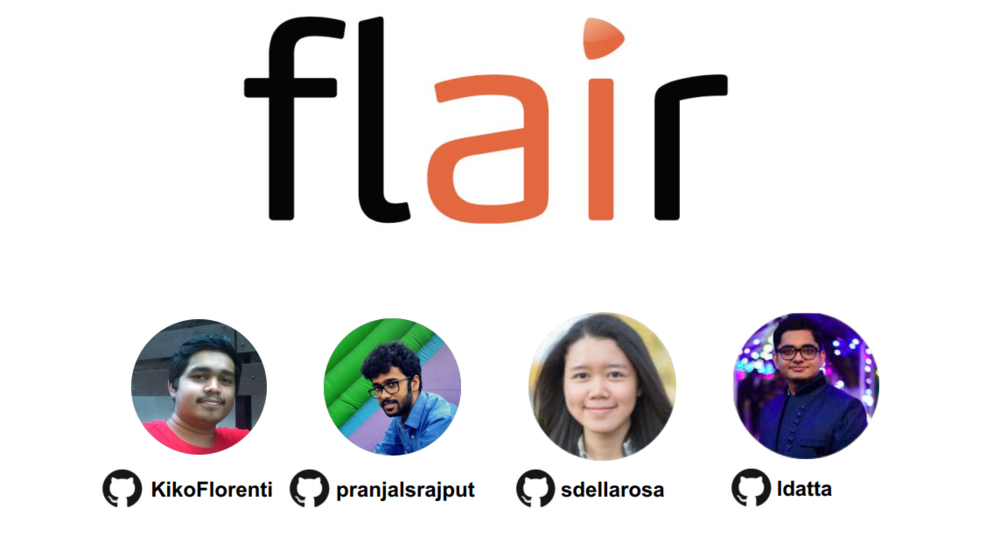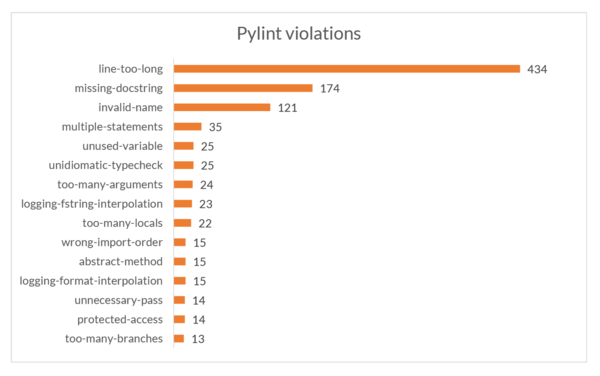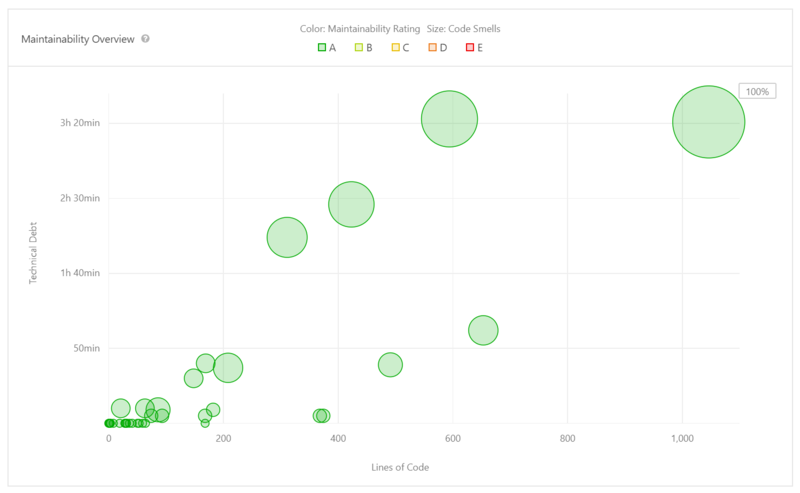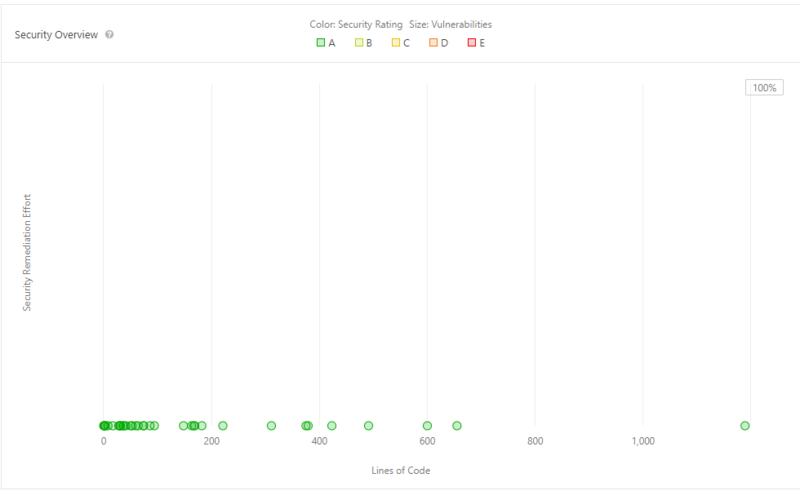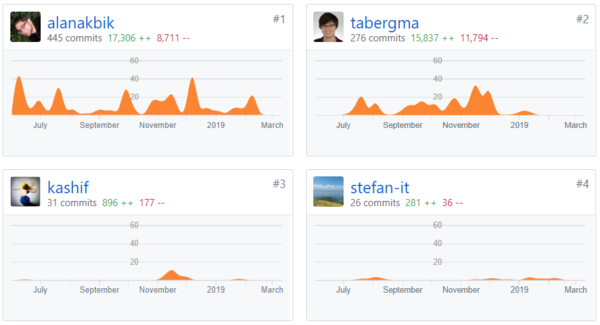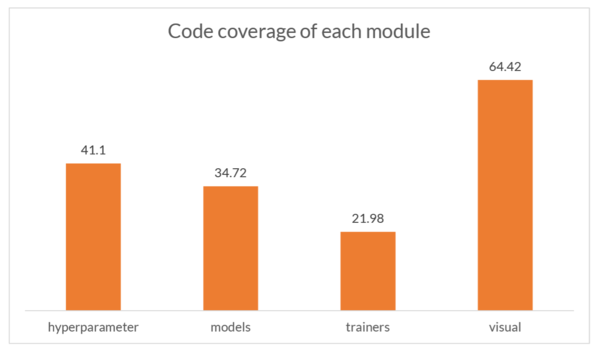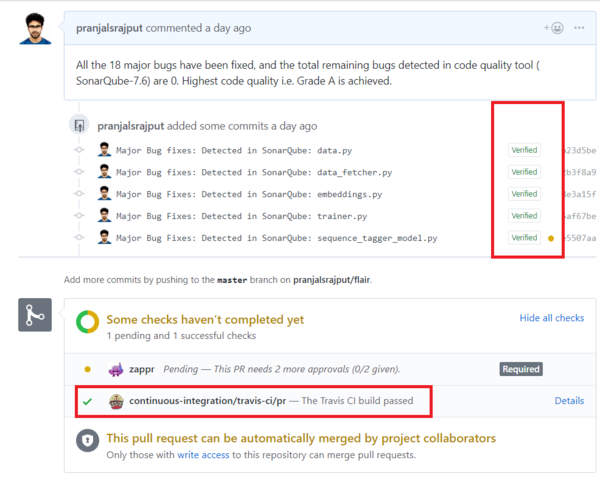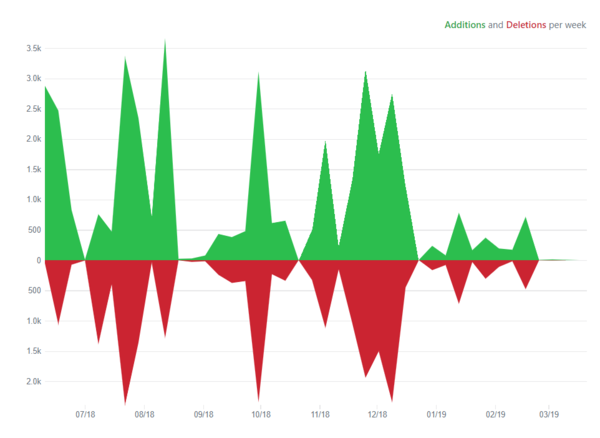Flair
Table of contents
- Introduction
- Stakeholders
- Context View
- Development View
- Technical Debt
- Functional View
- Performance and scalability perspective
- Conclusion
- Appendix
- References
Introduction
Flair is a state-of-the-art open source natural language processing framework developed by Zalando Research. Zalando Research is part of the fashion platform Zalando that aims to scale technology in fashion with the power of experimentation in theory and in practice. Flair released in July 2018 and is a novel approach where natural language modeling is leveraged to learn powerful, contextualized representations of human language from large corpora. Such representations possess a multitude of semantic and syntactic information that can be used to directly improve downstream NLP tasks.
The standout features of this powerful NLP library lies in the usage of Named Entity Recognition (NER), part-of-speech (PoS) tagging classification and sense disambiguation. It boasts support for a variety of languages and continues to grow with the help of many contributors. It consists of taggers that are ‘one model, many languages’, that is, a single model can predict the PoS or NER tags for given input text in various languages. Flair also provides a text embedding library with simple interfaces that allow for usage and combination of different word and document embeddings including the proposed Flair embeddings, BERT and ELMo embeddings. It is built directly on PyTorch which allows for ease of use in training and experimenting with models.
Stakeholders
Stakeholders in a software system refers to the individual, team or organisation that have interest in said system being realized. Each of these stakeholders have their vested interests and needs from the system. A myriad of stakeholders are involved in activites such as building, testing, debugging, etc. It is imperative to identify individuals or groups that are likely to affect or be affected by a proposed action and sorting them according to their interactions. Stakeholder analysis is done so as to identify and prioritize the role of the stakeholders.
We use the description of stakeholders obtained from Rozanski and Woods 1 to classify stakeholders. These stakeholders will be mentioned as Main Stakeholders. Stakeholders not part of the Rozanski and Woods classification, are described as Other Stakeholders.
Main stakeholders
| Type | Description |
|---|---|
| Acquirers | In Flair, control is orchestrated by Zalando which works on several real world problems. The researchers work on problems with the academic community, synergising with company objectives. Achievements of Flair will allow Zalando to properly utilize their resources. |
| Assessors | The conformance of Flair to research standards is regulated by Zalando. The quality assurance is divided within contributors at the GitHub repository. Alan Akbik, who wrote Contextal String Embeddings for Sequence Labeling with Duncan Blythe and Roland Vollgraf, mainly oversees the commits along with Dr. Kashif Rasul and Tanja Bergmann. |
| Communicators | Communicators act as conveyers of system specifications. To follow updates of Flair, watching the repository on GitHub is one way, followed by updates on their website. Akbik, Bergmann and Rasul are the communicators, which allows them to understand insights provided by other contributors. |
| Developers | Initial attribution goes to the research team for their work on the paper. The other contributions come from developers and researchers. This allows the original developers to gauge the performance of the framework and identify areas of potential growth. Akbik has the most commits with 445, followed by Bergmann with 276, and Rasul with 31. GitHub users such as Stefan Schweter are active during development. There are 36 contributors. |
| Maintainers | Bug fixes and maintenance are handled by both the developers and GitHub contributors. The maintainers are Akbik and Bergmann. They maintain the development of the library and check for functionality and version control. |
| Production Engineers | Potential Production Engineers, would want to manage releases and run tests on builds. At the moment, the task is relegated to staff developers. The focus should also be on ensuring that the library performs efficiently. The deployment of Flair is the responsibility of users. |
| Suppliers | The infrastructure used is that from the user’s side and therefore the users in a way are also suppliers of hardware in addition to Zalando. GitHub is also a supplier as it provides a common platform for contributors to develop. Google Colab provides alternatives for hardware constraints. |
| Support Staff | The Zalando Research team acts as support staff. Per Ploug acts as an intermediary between the external contributors and Flair developers. This also includes Henning Jacobs, the Head of Developer Productivity at Zalando SE. Her team uses various tools to measure productivity of the developers. |
| System Administrators | Since the library is used by users, they become system administrators themselves. This is also overseen by the Zalando team. System administrators are given the role of identifying issues with data associated with labeling and embeddings, performance problems and deviations from the desired non-functional performance requirements. |
| Testers | Testers in Flair are the core developers and other members of the research team. This includes Akbik, Rasul, Bergmann, Nikolay Jetchev and external testers include GitHub users such as Schweter, David Batista, and Nilabhra Chowdhury. |
| Users | The functionality of the system is used by students, researchers and companies. The scope of the project is understood mainly by people already well versed in NLP. Flair is already part of several in-production systems at Zalando, as machine learning has become a natural part of their engineering toolbox. |
Table 2.1: Main stakeholders of Flair
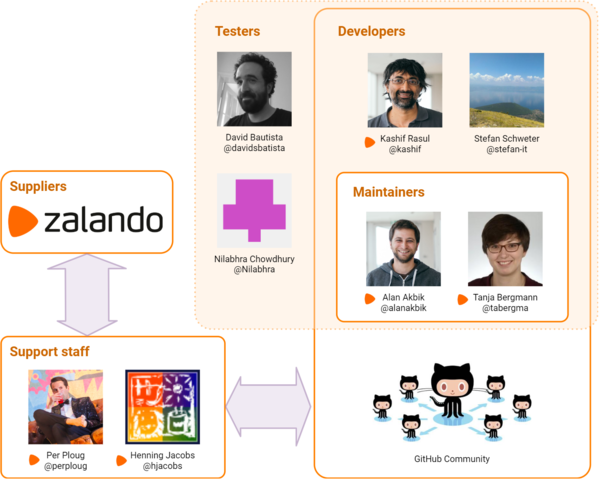
Other stakeholders
Researchers and Scientists: They use the system to research and present findings. The use of embeddings and labelling in tagging are of vital interest.
Competitors: The most widely known library is NLTK which supports tasks like classification, tokenization, stemming and semantic reasoning. It is difficult to use and considerably slow. Gensim is a Python library that specializes in identifying semantic similarities between two documents through vector space modeling.
Translators: At the moment, the NLP tasks can be performed on languages such as English, Dutch, Spanish, German, Polish and a few others. Other languages are not supported yet and Flair invites developers to contribute to the corpora and the embeddings list in order to support more languages
Enthusiasts: There are several students and developers who are interested in performing NLP tasks and would therefore find contributing to Flair an exciting way to broaden their horizons.
Bloggers/Social Media: They are unambigous and provide reliable sources of information for new developers to start contributing. They also help bring the project into limelight. This article is an example of a website providing a tutorial and this article is an example of a blogger sharing their insights.
Sponsors: Even though the library is an open source, it originated from the Research Team at Zalando. Setting up of architecture and funding for research is provided by Zalando. The results of the research are essential for Zalando to further its business operations.
Integrators: Integrators are the architects and core developers of Flair who are responsible for maintaining code standard and consistency of Flair. Developers like Akbik and Bergmann are the main integrators here. To keep the framework stable, they merge Pull Requests (PR) which they successfully align with their versions of sources and languages. When a new module is added, they check if the change is needed and also verify documentation changes. This procedure helps maintain the quality of the framework, keeping it open source as well. To discuss the challenges of the integrators, one important aspect noticed is that sometimes, a major part of the PR works on test set whereas a small part does not give expected test result. In these cases, the PR is not directly closed. It is kept as open, the integrators comment on the errors they face, and suggest what changes can be created to overcome that. Sometimes, the same contributor makes the required changes or other contributors have a chance to solve the issue as well. After reviewing the code and checking for errors, the PR that meet their requirements are merged.
Stakeholder analysis: Power vs Interest Grid
Based on Mendelow’s Power vs Interest Grid 2, the groups of stakeholders necessary to be managed closely are classified.
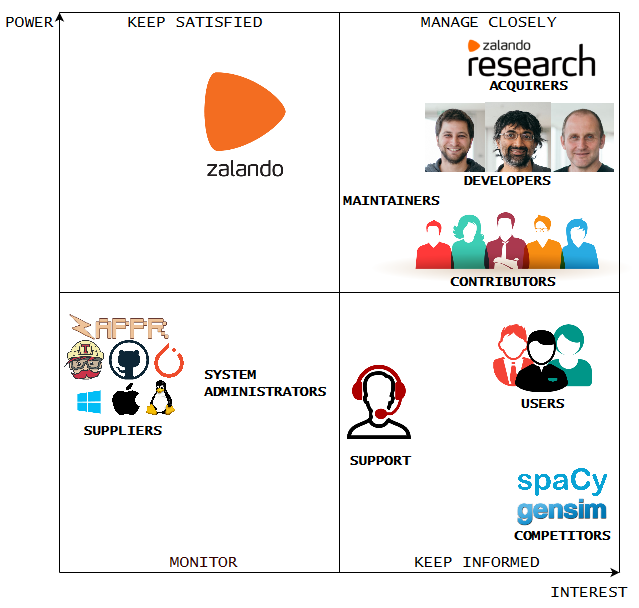
The Power Interest Grid for Flair is used to classify the groups of stakeholders necessary to be managed. Most of the stakeholders mentioned earlier are included in the Grid. While users have a high interest in Flair, suppliers do not. Suppliers have more power and should they decide to stop supplying, then Zalando will have to adapt their products accordingly. The contributors, maintainers and developers need to be managed closely because of their inherent interest in the product and the power they hold in influencing design and development.
Relevant people to contact
By analyzing the online community around Flair we found that the following people are the most involved in the project. The relevant people and persons of interests were identified and can be found in Appendix B.
Context View
Context view describes a software’s dependencies, integrations, scope, responsibilities and interface with external entities. In Flair’s context, we will show a context view diagram, discuss the system scope and analyze the interfaces with all its external entities.
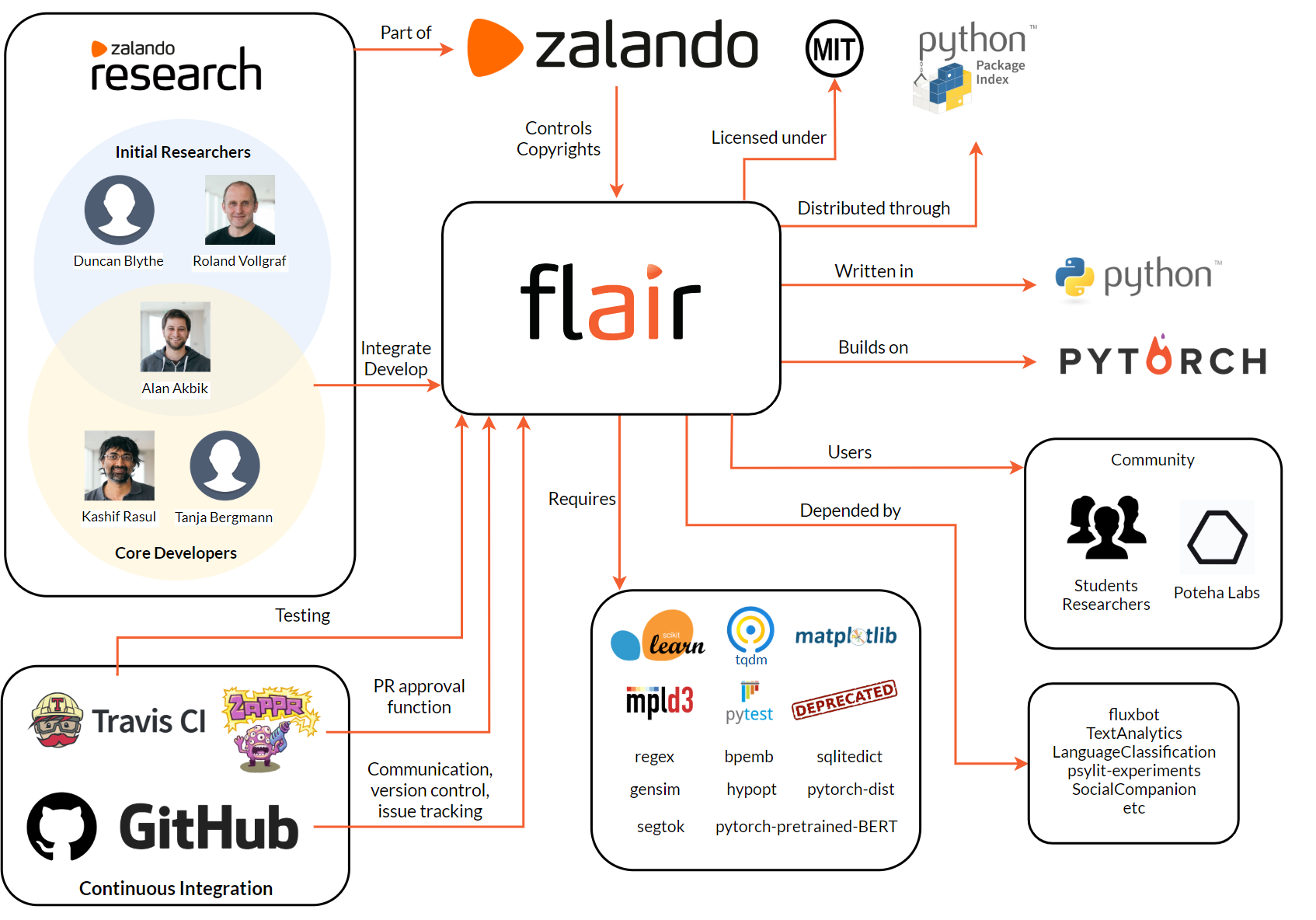
System scope
Flair is a research project of Zalando Research, in the area of NLP. Flair is a cutting edge NLP framework, advancing over all the other existing methodologies. The scope of Flair is well defined and its current version includes the following capabilities 3.
- Built upon Pytorch 0.4+ which is compatible on all operating systems: Windows, MacOS and other Unix-based OSs, and that helps in training your own models.
- Can be easily installed using a pip command.
- It is used to read, understand and learn the contextualized representation of the human language.
- It helps in understanding and classifying the email responses, website comments or customer responses.
- Flair can be trained to recognize fashion concepts such as season, brand, and color.
- Supports state-of-the-art Natural Language Processing models such as name entity recognition (NER), part-of-speech tagging (PoS), sense of disambiguation and classification.
- Supports 36 word embeddings for 31 different languages, character embeddings, Byte Pair embeddings (275 languages supported) and stacked embeddings.
- There were 7 different releases till now and the current version is
Version 0.4.1.
External entities and interfaces
- Flair is licensed under the following MIT License (MIT) Copyright 2018 Zalando SE.
- It is written in Python 3.6, which provides the framework and programming language.
- It is developed by core committers, developers, community contributors and product managers.
- Users are developers and the organizations that use Flair. Flair is used by Poteha Labs in their research work, by student researchers, and at several in production systems at Zalando.
- Communication channel is used for communciation between developers and users. Flair uses GitHub mainly as its communication channel for interaction with the team. It’s also being used for version control. Github is also used for logging issues in the system and for keeping track of them.
- Flair uses Travis CI as a build tool for building its code and thereafter integrating the build. It also uses Travis CI as a testing platform.
- It has interfaces that allows to combine different word and document embeddings, including BERT embeddings, Flair embeddings and ELMo embeddings.
- Flair hosts their bug bounty program privately on HackerOne.
Development View
Through the theory of development view, we address several aspects of the system development process. Due to the associated complexity of the framework being built, the expertise of the core developers and technologies used are discussed. In the following sections Module Organization, Common Design models and Codeline models are discussed.
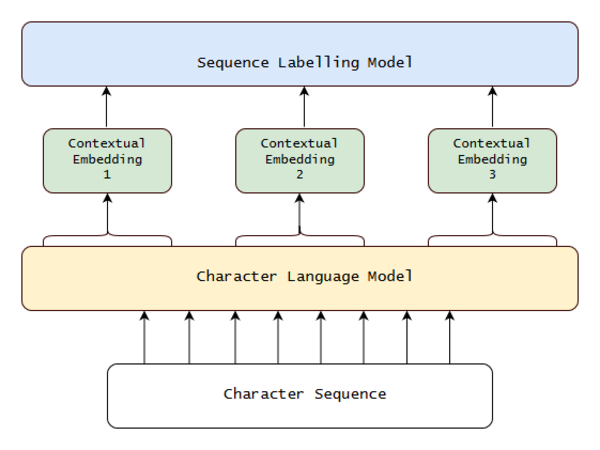
The diagram describes a general language model used by Flair. The structure varies based on the kind of embeddings. We start from the bottom, where a sentence is put in as a character sequence into a pre-trained bidirectional Character Language Model (CLM). From this CLM, they retrieve for each word a contextual embedding by extracting the first and last character cell states. This word embedding is then passed into a sequence labeler, such as a vanilla BiLSTM-CRF, achieving robust state-of-the-art results on downstream tasks.
Module structure and organization
In this section, we detail Flair’s module organization, as well as important dependencies between modules, in order to obtain a good understanding of Flair’s code structure, based on 1. The inter dependency of the modules are shown in Figure 4.2.
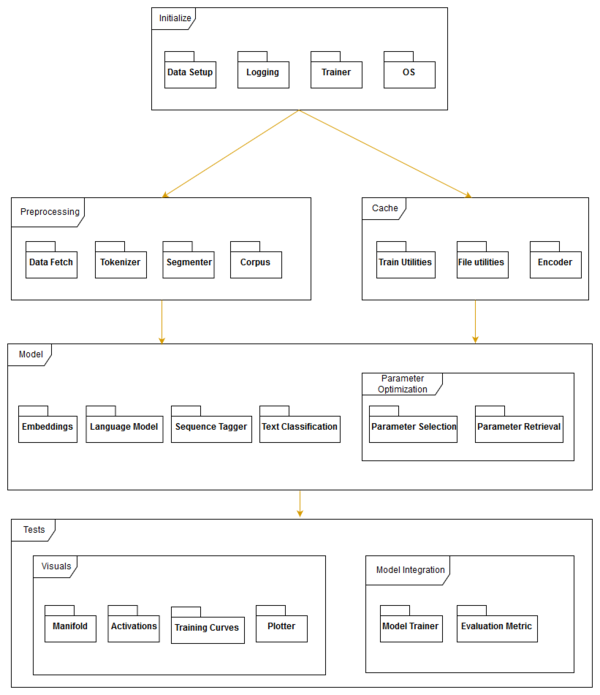
The projects is run directly on a single repository. It is seen that there is high cohesion and
low coupling. The high cohesion stems from the model and test module and the
low coupling can be seen from the division of several modules for only certain
associated functionalities.
- The
Initializepackage is used to check for compatibility and versions of OS, Pytorch, Cuda and others. TheData Setuppackage is used to setup up data fetchers, model initializers and logging tools. - The
Preprocessingmodule handles text, word and document embeddings-based preprocessing , including tagging, and labeling. - The
Cachemodule deals with utility history for training purposes. It helps encode embeddings into available embeddings list. - These embeddings can be selected along with the associated
Language Modelin order to determine the classification algorithm. Parameter Optimizationhelps select parameters such as document length, batch size, or weights. The results are tested by visualizing plots and training curves.
Common design model
This section covers Flair’s Common Design Model. Commonality across different versions of Flair is done by defining a set of strict design constraints.
Common processing
In Flair there is common processing among different elements in order to simplify the integration of code units and scripts. We discuss the common processing elements here.
-
Initialization of Flair follows the usage of a particular task such as embedding. Here, NER task is shown. Every embeddings, labeling and language model task has predefined ways of initialization and implementation as given in the tutorials.
from flair.data import Sentence from flair.models import SequenceTagger # make a sentence sentence = Sentence('I love Berlin .') # load the NER tagger tagger = SequenceTagger.load('ner') # run NER over sentence tagger.predict(sentence) -
Use of third party libraries exists in the framework of Flair. Flair makes use of third party libraries whenever possible, which we consider to be a standard design approach. We see that in the embeddings, pytorch-pretrained BERT embeddings are used, and certain modules from scikit-learn, gensim and NLTK are also included.
-
Through Instrumentation, we can measure the performance of a particular metric. The console log and statistics are sent to the developer when tests are run on the integration build using Travis CI.
-
Owing to the large processing load that Flair tasks can put the user system in, it is also recommended for the contributors to make use of Google Colab.
-
Flair has a clear standardized design methodology and testing procedure when it comes to contributions and changes.
-
Security issues are acknowledged by Zalando and they try to be responsible by patching quickly. They host a bug bounty program on HackerOne. Vulnerabilities are also posted using this form.
-
Database Interaction is streamlined by ensuring that newly added corpus are first tested. Once they pass the tests, the datasets are added to the available corpora and the resultant embeddings trained are added.
Standardization of design
The Flair repository has the Contributor Covenant Code of Conduct and Contribution guidelines. There is provision of tutorials that provides guidelines for setting up the libraries and embeddings, using pre-trained models, adding your own corpus to train your own models and to train embeddings.
-
The tutorials provide details on using libraries and embeddings while creating new embeddings and models. Any steps taken towards issue creation, contributing to issues, making use of pull requests and merging them must be done in concordance with the Code of Conduct and these contributions should fulfill the Contribution and Commit Guidelines.
- Having a global reach allows developers to train and test the language models on
different languages other than those already supported by Flair. To maintain a supportive, active community the
conduct of conduct states:
In the interest of fostering an open and welcoming environment, we as contributors and maintainers pledge to making participation in our project and our community a harassment-free experience for everyone, regardless of age, body size, disability, ethnicity, gender identity and expression, level of experience, nationality, personal appearance, race, religion, or sexual identity and orientation.
-
The coding style employed in Flair requires the developers to follow the Style Guide for Python to maintain conformity. Since the library is still under development, it is necessary to request the developers to set or ask developers to employ any other aspects of coding styles they want to.
-
Flair is built using Python 3.6+ as per the requirements. It is mentioned that the expectation from developers is to follow the standards of coding style as defined for each module and library used. The regex guide give tips on regular expressions. The Gensim guide provides tips for using Gensim.
-
Logging is essential for developers during development to ensure that the system worked as intended and can be understood by another developer.
- Design Patterns is used sparingly. The aim of Flair is to focus on performance. As a result, Flair avoids design patterns which in turn acts as an obstacle towards the readability of the code. Different pieces of code working on the same or similar task can look different and would mainly require explanations or comments from the contributors rather than what is mandated by the developers. It makes it more difficult for someone to contribute to the project because the developers might want to see particular code patterns, but these patterns are not communicated to contributors.
Standardization of Testing
The standards of testing in Flair are mainly dependent upon integration checks and verification of pull requests that developers make. In this section, the tools used for testing purposes are discussed.
- There are tests specified for a variety of NLP tasks that need to be accounted for. The design pattern followed for testing involves individual task based tests and then integration and build tests. The task based test specifications detail the tests that the partiuclar tasks must pass. Furthermore, the integration to complete the pull requests are tested with Travis CI and Zappr.
- For autoamted testing, Flair uses Travis CI (continuous integration) and it is ran on all pull requests and all commits to a branch to verify that it builds and it passes testing. Regardless of which type of CI run for testing, all CI jobs must pass before the pull request is merged by Flair maintainers.
- The process starts at the .travis.yml file in the root of Flair repository. It specifies all the steps for building a test environment. The build lifecycle is made up of two steps, one is install which installs any dependencies required and the other one is script which runs the actual tests. In script, multiple script commands are specified. If one of the build commands returns a non-zero exit code, the Travis CI build runs the subsequent commands as well, and accumulates the build result.
- Using Zappr developers check for patterns in pull requests. At least two approvals from other people including collaborators are necessary conditions. The .zappr.yaml file contains other details on how to determine which pull requests are valid based on conditions set.
Standard software components
- The dependencies on which Flair depends are standard components required for the funcitoning of the Flair Model. This can be seen in the requirements page. These include gensim, pytorch and other dependent software. All developers aiming to contribute must have these rquired base and dependency software installed in compatible environments.
- Zappr is a GitHub integration built to enhance your project workflow. Built by open-source enthusiasts, it’s aimed at helping developers to increase productivity and improve open-source project quality. It does this primarily by removing bottlenecks around pull request approval and helping project owners to halt “rogue” pull requests before they’re merged into the master branch.
Codeline models
- Source code structure: The complete directory organization of Flair can be seen in Figure 4.4.
- Build approach: Flair uses Pull Request Workflow. The straightforward approach makes it easily understandable for contributors and provide them with naming conventions, files etc. Following a Pull Request Workflow helps the developers make contributions via GitHub and allows other contributors to read code changes and make remarks when there are errors or issues in the requested PR. Some PRs have discussion threads, giving more insights about how testing is done and what parameters are checked before a successful merge. The merge is complete only after a final check is carried out in Zappr.
-
Release process: The release process does not contain any fixed timing, unlike a weekly or monthly release. As of now, no such fixed release process has been mandated by the core developers. However, the last few versions have been released once a month. In fact, Flair now has had a total of 7 releases. The developers are working towards a stable release and therefore are working on the master branch. Bug fixes made and potential speed improvements achieved are highlighted.
- Configuration management: Flair is managed directly on GitHub and new versions on Flair are released through GitHub releases. The reliability on GitHub is due to its provision of a competent version control system to maintain the source code. This supports repetition via commits and branches. The configuration structures used are repositories, branches, tags, commits, pull requests, issue trackers and milestones.
- Contact with the developers: The initial point of contact starts from Issues. The developer or contributor can discuss and deal with build-specific issues like bugs, errors, crashes and compilation errors. Most of the issues are closed within a week but there are certain issues that take more time.
- Pull requests: Pull Requests, allow for contribution and addition of new features, fixes and bug corrections, and optimization of current features. First time contributors are encouraged to look into issues already posted by others in need of help. The official guidelines mention details for contributing with pull requests, checking for issues and explain the Git Commit process. Every pull request is reviewed by Akbik, Schweter and Bergmann.
- Travis CI : Flair uses Travis CI to manage continuous integrations to build and test Flair on the fly.
When new commits are pushed to the repository,
the specifications and commands in the
.travis.ymlfile will be run and then project is built. The results of the tests are sent to the developers and maintainers including job logs for specified pull request. - Zappr: Flair makes use of Zappr , a GitHub integraiton developed by Zalando. Zappr makes it easier to manage project workfows. Flair makes use of Zappr to restore and improve code review. Using Zappr, the developers are able to enable/disable pull request approval checks per repository, with the simple flip of a toggle, configure what counts an approval and what doesn’t and can provide a configurations file that overrides Github’s default settings and endows users with PR approval authorization.
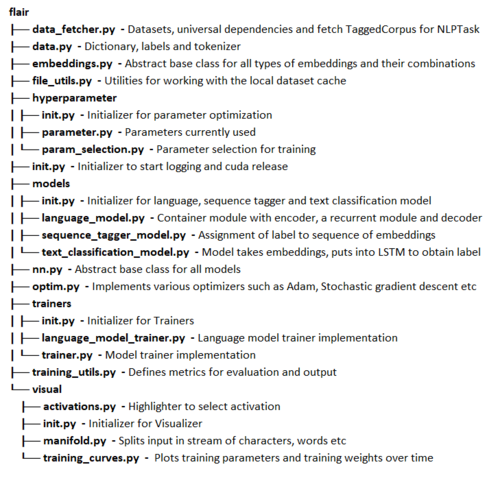
Technical Debt
Technical debt is a metaphor that describes the immature artifact in the process of software development, that causes an additional rework because of choosing an easy solution over a better approach that would take a longer time to implement. Main reasons for technical debt are leaving the tasks undone, copying and pasting a piece of code, negligence to lessen the code complexity, incomplete unit testing, and lack of proper documentation. In this section, we will discuss the technical debt and its handling by the community. For this purpose, we used two tools, Pylint and SonarQube to analyze the code quality of Flair.
Pylint
Pylint is a bug and quality checker for Python which follows the style recommended by Python style guide PEP 8. Pylint gave the package an overall rating of 7.08 and detected 1168 violations. Although, we note that some of the violations are not major. For example, 418 violations due to lines that are too long, i.e. they have more than 100 characters and 124 violations are caused by invalid variable or argument names that do not conform to the recommended naming style.
As shown in Figure 5.1, we see the second most common violation is missing docstrings. It is necessary to put docstrings on functions, methods, modules, and classes in order to preserve maintainability of the software, as docstrings would allow other contributors to better understand what the specific part of the code does.
Pylint also found one important violation, in that the module embeddings.py
contain 1939 lines, which is almost double the recommended 1000 lines. This also
affects maintainability of the code as a very big module is harder to maintain
and might end up causing unnecessary dependencies when extended.
SonarQube
SonarQube is a framework that detect bugs, code smells, duplicate code, and security vulnerabilities of a program in many languages, including Python.
Bugs
SonarQube detected 18 bugs in Flair codebase. All the 18 bugs are major issues, and hence the code quality has been graded as C. All the bugs are related to the useless assignment to variables. They have no such impact on program functioning but useless variables consume the CPU memory which reduces the performance while training heavy data in Flair. These can be fixed by either removing the redundant variable or by assigning it some different value that was intended for the assignment instead.
Vulnerabilities
Vulnerability detected by SonarQube is 0%, that means code quality is very good from security point of view. The code quality has been graded as A.
Code smells
Code smells are one of the major contributors to technical debts, and indicates the weakness of the code, and may cause the increased risk of failures or bugs. They are not actually bugs and do not cause any hindrance in program functioning. Total 61 Code Smells detected by SonarQube, most of them are related to Cognitive complexity, that asks for changing the logic of the program because of inclusion of nested loops or conditional statements. As Flair is an NLP library and needs to train large amount of data. So it takes a lot of time to train. These code smells therefore makes the program slower as well as increases the chance of failure or bugs in future. So, fixing these will bolster the performance of Flair.
Duplications
One of the worst coding practices is duplication. Duplicating a block of code not only replicates the potential issues but also breaches the coding standards. SonarQube has detected 668 duplicated lines in 5 duplicated files. An overall of 7.2% duplication is detected in Flair codebase. The duplications are due to similar functions performed for counting the embedding length of different embedding classes. This could be removed by implementing a base function in the abstract base class that could be used by the different child classes.
Dependencies on developers
It is noticeable that the product development is highly dependent on two of the core developers, Akbik and Bergmann. A huge difference between the contributions of these two and the other developers of the product can be seen in the graph below. This has created a high risk of project collapse in case one or both core developers leave the team. Ideally, there must not be too much dependency on a single developer, instead majority of the developer community must be equally contributing.
TODO and FIXME comments
TODO or FIXME are the special type of comments that can be added inside the line or block comments for any future references of possible changes, areas of improvements, and optimizations. It is a good indication of technical debt.
We found 2 TODO comments in 2 files in Flair’s codebase. This is a very low number for TODO comments. This can be seen in different ways. Firslty, they might be fixing TODO tasks on time and not piling them up in code, which actually is an ideal coding practice. Secondly, they might have removed the comments and have logged an issue instead in GitHub, which actually is a better practice rather than keeping it inside code and creating techincal debt.
The small number of TODO comments is actually an indication of good coding practice, but still these remaining ones needs to be fixed.
Testing debt
A part of technical debt is to measure how thoroughly the software is tested. This is also called the testing debt of the system. Even though a program may be tested regularly after a change is made in the code, it is important that all modules of the program are covered by the tests. In other words, we need to ensure that the code coverage is high.
Testing procedure
Flair uses Travis CI to test
their product. Each commit to the git repository
will trigger a build on Travis CI where a virtual environment on Travis CI’s
server will be set up. All the required packages will then be installed in this
virtual environment, then the test modules under the tests/ directory will be
run in this virtual environment. The code must pass all the tests.
There are 12 tests in total.
Code coverage
Pytest is a framework that can be used to both test and report the code coverage of a Python program. We used this tool to find Flair’s code coverage, then we sent the results to coveralls where the well-tested and less-tested modules are shown in detail.
The result tells us that only 1912 of 4295 relevant lines (44.52%)
have been hit at least once by one of the test cases. In Figure 5.8, we see
that visual is the most well-tested module while trainers is the least
well-tested one.
Although the code coverage seems rather low in most of the files and modules,
a closer look into the lines missed revealed that many of them are contained
within an if block. This means that the if conditions are not satisfied
during the tests. Considering that Flair is a language processing framework
that needs to have different processes for different languages and the fact
that the tests only use resources in English, it makes total sense that the
code coverage would be rather low.
Actions to improve testing
As discussed earlier that many conditions are not hit due to the separated conditions for each language, the testing could then be improved by augmenting the test resources. Although, we also note that this could drastically improve the testing time.
Discussions about technical debt
There are no discussions about the technical debt between the developers, which is quite shocking. It seems like they are not using any code quality tools. Regardless, the code quality is of the highest level, which actually is a good thing. However, its highly recommended to use one so as to avoid having any future technical debts.
Payment of technical debt
We tried to pay the technical debt by improving the code quality from Grade C to Grade A. This is done by fixing all the 18 major bugs that are detected in SonarQube, to now have 0 bugs in the system. Same source code style is used as in project and its ensured that no new bugs are introduced because of this fix. A pull request (#616) has been created in the master branch of the project Flair, which is still pending and needs to be approved by the owner and then merged. Also, the code build was verified and passed in Travis CI.
Evolution perspective
Development of Flair was started in the summers of 2018 by Zalando Research and is licensed under MIT 3. It was made an open source Python project by Zalando SE in June, 2018 3. Its based on the research done by Akbik et al. Akbik is the main developer since the start of the project and still is the head developer.
The first draft of the project Version 0.1.0 was released on Jul 13, 2018 3. Since then, 998 commits have been done to the master and 7 different versions have been released,
with Version 0.4.1 being the latest 3. Technical debt is paid in every release by timely fixing bugs. Also, code is being reorganized if needed, which helps in reducing
technical debt like duplications. Documentation is done for every new feature add or for any updation. Different new features were added and improvements were done over the period
of time in different releases. Some of the key features of different releases are shown in Figure 5.12.
There are 93 issues still open, and 294 are closed 3. Most of the open issues are of question label, but the bug count must be kept zero. Also, there are 6 pending pull requests,
which must also be taken into consideration.
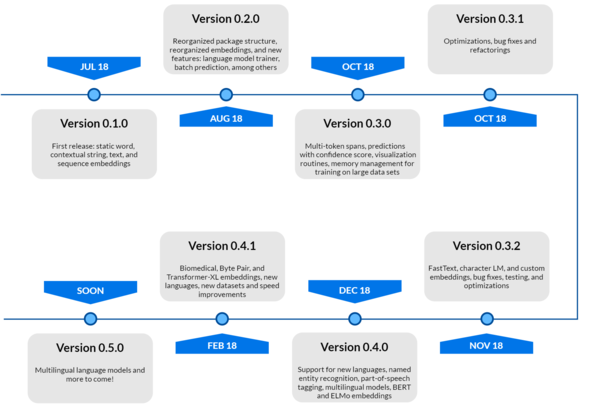
Functional View
Functional view mainly describes systems architectural elements. It explains about primary interactions between the functional elements, their exposed interfaces and their responsibilities 1.
Functional capabilities
Functional capabilities define what the system is required to do and what it is not required to do 1. Flair has many capabilities and some of the most vital ones are listed in the table below.
| Modules | Description |
|---|---|
| embeddings.BytePairEmbeddings | Supports 275 languages. Very useful for training small models. This can also be used in sequence tagging. |
| embeddings.TransformerXLEmbeddings | As proposed by Dai et al. [?], this embeddings address the limitation of fixed-length contexts, as a notion of recurrence is introduced by reusing the representations from the history. |
| embeddings.ELMoTransformerEmbeddings | Uses a bidirectional recurrent neural network to predict the next word in a text. |
| embeddings.DocumentRNNEmbeddings | This class allows to choose which type of RNN to use. |
| embeddings.FlairEmbeddings | Trained without any explicit notion of words and model words as sequences of characters. Same word will have different embeddings depending on its contextual use. |
| embeddings.WordEmbeddings | Supports pre-trained FastText Embeddings for 30 languages: English, German, Dutch, Italian, French, Spanish, Swedish, Danish, Norwegian, Czech, Polish, Finnish, Bulgarian, Portuguese, Slovenian, Slovakian, Romanian, Serbian, Croatian, Catalan, Russian, Hindi, Arabic, Chinese, Japanese, Korean, Hebrew, Turkish, Persian, Indonesian. |
| data_fetcher.NLPTaskDataFetcher | This can be used to load different datasets using the load_corpus() function. |
| trainers.ModelTrainer | This is used to train a user’s own language model embeddings. It supports multi-dataset training using a MultiCorpus object. |
| models.LanguageModel | Container module that has an encoder, a recurrent module, and a decoder. |
| models.TextClassifier | The module takes word embeddings, puts them into an RNN to obtain a text representation, and puts the text representation in the end into a linear layer to get the actual class label. |
| models.SequenceTagger | Contains several pre-trained English and Multilingual models, which include Named Entity Recognition (NER) and Part-of-Speech Tagging (POS). The function load() can be called with the appropriate string to load a model. |
Table 6.1: Some of Flair’s most vital modules
Functional structure model
Flair has three major functional elements: embeddings, model trainer, and train and file utitilies. Flair uses its train and file utilities to read corpus objects with which a model can be trained. There are several different embedding classes that Flair provides, but all of these embeddings can be classified into three types: BERT, ELMo, and Flair embedding classes. The user can choose to perform a named entity recognition, part-of-speech tagging, and sequence tagging using one of these embeddings.
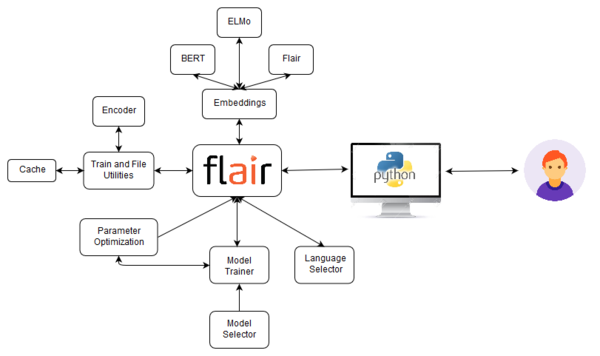
Performance and scalability perspective
Performance
| Task | Language | Dataset | Flair | Previous best |
|---|---|---|---|---|
| Named Entity Recognition | English | Conll-03 | 93.18 | 92.22 (Peters et al., 2018) |
| Named Entity Recognition | English | Ontonotes | 89.3 | 86.28 (Chiu et al., 2016) |
| Emerging Entity Detection | English | WNUT-17 | 49.49 | 45.55 (Aguilar et al., 2018) |
| Part-of-Speech tagging | English | WSJ | 97.85 | 97.64 (Choi, 2016) |
| Chunking | English | Conll-2000 | 96.72 | 96.36 (Peters et al., 2017) |
| Named Entity Recognition | German | Conll-03 | 88.27 | 78.76 (Lample et al., 2016) |
| Named Entity Recognition | German | Germeval | 84.65 | 79.08 (Hänig et al, 2014) |
| Named Entity Recognition | Dutch | Conll-03 | 90.44 | 81.74 (Lample et al., 2016) |
| Named Entity Recognition | Polish | PolEval-2018 | 86.6 (Borchmann et al., 2018) |
85.1 (PolDeepNer) |
Table 7.1: Comparison with state-of-the art
As shown in Table 7.1, Flair outperforms the previous best in
different range of NLP tasks like Chunking, Named Entity Recognition, Part-of-Speech
tagging. It supports best embedding configurations for each task. The performance
is measured over evaluation datasets, and the F1 score for each dataset is
calculated by averaging over five runs
4. In the latest release Version 0.4.1, there is a huge
improvement in the training speed compared to the previous versions of Flair (2x training speed for language models)4.
Flair achieved optimal results in text classification outperforming Facebook's FastText in accuracy & Google’s AutoML Natural Language in training speed on Kaggle’s SMS Spam Detection Dataset 5.
Flair model achieved an f1-score of 0.973 after 10 epochs while FastText achieved f1-score of 0.883 5. It beats AutoML in terms of training speed and achieved slightly better accuracy than it 6.
Scalability
Scalabiity with regards to Flair involves handling larger corpus of text in a quick manner with appropriately scaled usage of hardware. It is difficult to gauge the growth of Flair considering the increase in data set size. Although, until now it has been able to handle vast sizes of corpora. The model has had many scalability improvements over throughout its releases.
| Scalability Issue | Details |
|---|---|
| Language model optimizations | Lowers default dropout rate and only send mini-batches to GPU for better GPU memory usage. |
| Data loading | Implemented Pytorch capability to load in parallel Dataset and DataLoader classes which cuts training time in half. |
| Hardware requirements | Usage of a centralizeed hardware resource is proposed similar to Google Colab. |
| Implementation changes | Faster inferencing by presorting sequences and embeddings are cleared after processing each batch, thereby saving a lot of RAM. |
| Optimizations | Changes made to the hyper parameters and other memory tweaks. |
| External dependencies | Since the framework depends on CUDA for training, changes made to their implementation must be reflected in Flair. This included memory and parameter tweaks. |
Table 7.2: Scalability changes
From a technical standpoint, the data must no longer be loaded in big batches onto RAM directly, instead, it must be asynchronously loaded to the disk. Other tasks such as regression must also be supported by the framework and addition of such features is made easy. Multiple-tasks learning can be included along with multi-GPU support with the changes to the new CUDA semantics. These features while make scaling of Flair easier.
Conclusion
Flair provides an innovative framework for natural language processing. Within a short period of time, Flair has grown fast and challenges existing NLP frameworks. This growth has been possible through their specific code of conduct for code writing and analysis, constant code quality, and well structured documentation. We have analyzed Flair through various perspectives and viewpoints to have an insight on its internal workings. Its well-built architecture, integration between different modules though maintained common processing, standardization of design and testing has helped Flair to provide a good performance.
Appendix
A. Pull requests analysis
The pull requests made through github are analysed using standard code of conduct. The code of conduct includes naming conventions, way of codes, standard of code and versions of sources used. This strict follow up of the conduct makes the original code and merged codes quite readable and easily understandable also. Whenever new modules are added, emphasis is given in order to update the documentation as well. As mentioned earlier, integrators check for code standard and versions of PR before the merge. On the other hand, the opened issues that are solved by other contributors in separate PR are closed. This does lead to less confusion about PRs. The closed PRs are sometimes those who are considered to be not at all matching their base mark and also totally unstructured. Also, naming conventions sometimes become a major reason for closed PRs.
| ID | Pull Request | Status | Details |
|---|---|---|---|
| #399 | Add new ELMoTransformerEmbeddings class | merged | In this pull request, the contributor adds new class named ‘ELMoTransformerEmbeddings’ for Parts of speech tagging. In NLP, PoS tagging is an important step towards processing. The new class gets embeddings from a transformer-based ELMo model from another contributor @brendan-ai2 which one uses for training. The allennlp library is used for PoS tagging. Though the version of allennlp used was not yet updated in the flair main system, so testing was separately done and this successful testing outside the main system with latest version of allennlp suggested a good merge. So, it is merged but as experimental. |
| #523 | GH-522: Transformer-XL embeddings | merged | This PR adds a new embedding class for Transformer-XL model. Initially the tokens from a sentence were returned with tokens tag only bur this also included enumerated token tags. Also, the F-score of the tests increases a lot with the new embedding and the PR was accepted. |
| #473 | GH-438: added byte pair embeddings | merged | It embeds BPEmb library for for sequential tagging. It adds the BPEmbSerializable (BPEmb) class which embeds sequential tagging using torch library in tensors. It was accepted because the sequential tagging can also be deserialized when required like updating the cache_dir variable. The changes are merged after the development of the software and launch. |
| #164 | Added class-based metrics | merged | This basically improves the metric class through updating the TextClassifierTrainer function and removing calculate_class_metrics and the calculate_micro_avg_metric. The changes are merged after the development of the software and launch. |
| #538 | Adds Attentional BiLSTM in the Text Classification architecture | merged | Flair used standard BiLSTM model for text classification whereas this PR introduces Attentional BiLSTM model for this. The basic introduction faces error especially for training. So, the new PR generated with code updates were accepted with Attentional BiLSTM model. The PR was merged after launch of initial version. |
| #557 | Fix permission error in Windows | merged | This fixes issue #548. It was unable to delete the file which was previously opened (thus, marked locked). More precisely, mkstemp() opens the file, which then creates a lock on the file, therefore prohibiting Windows from deleting it.The updated function mktemp() does not do this. SInce it does not create the lock, files can be deleted when necessary. |
| #551 | GH-550: Fix bert model check | merged | This PR fixes an #550 which occurred due to a code fix mistake from the #523. The issue raised becaused the code did not include bert_model in BERT_PRETRAINED_MODEL_ARCHIVE_MAP.keys(). The inclusion of the model was tested successfully and merged. |
| #555 | Remove BERT_PRETRAINED_MODEL_ARCHIVE_MAP check to support Custom models | merged | This issue was due to version change of pytorch-pretrained-bert. This issue was also raised at #554. the BERT_PRETRAINED_MODEL_ARCHIVE_MAP was removed from the model as solution. |
| #71 | GH-38: Add label class for sentences to hold label name and confidence value | merged | It introduces a new class lebel which creates new label for the sentence. Each label has name and confidence value (between 0 and 1). It is used to predict return label/tag plus confidence value. It was merged after the development and launch of the system. |
| #519 | Added PubMed embeddings computed by @jessepeng | merged | A character LM over PubMed abstracts was calculated by @jessepeng. This PR embeds the PubMed to the system with FlairEmbeddings model. Additionally, it needed a few details like batch size, layers, hidden size, train size etc for the documentation which was added by this PR. It was merged after the development and launch of the system. |
| #88 | embeddings.py 213 214 a warning | closed | GitHub user @wuwingzhou828 proposed a change to certain lines of code in the section where the standard static word embeddings are defined including GloVe or FastText. It pertained to an if statement, where in case a certain precomputed word embedding already existed that particular embedding is fetched using the token.test parameter. Initially the change is accepted by Alan Akbik but merging is held on until all test were completed. However, the user made some errors in the correction as well and therefore the request was closed by Tanja Bergmann. |
| #490 | GH-68 Bert update | closed | Pull request was made to clear issue #68 regarding the implementation of a pipeline by a transformer based model implemented by OpenAI. The issues pertaining to addition of transformer models are discussed. They added Bert embeddings to the library. As a result the pull request refers to changes in the files setup.py and pytorch, thereby updating the BERT version. However, a newer version updated by user stefan-it was released with the updates made in Flair version 0.6.1. |
| #22 | GH-226: add safeguard for non-tokenized input | closed | User @jfilter opened a request to address the issue of a ValueError if the input is not whitespace tokenized and no tokenizer is used and therefore causes an infinite loop. However, the issue was already fixed in GH-232: multi dataset training #236 |
| #494 | calculate macro-f-score as average of class f scores | closed | There was probably an error in calculation of macro F1. Flair is taking average of class precisions and recalls and then calculates F1. As far as is known, it should be F1 calculated over classes and then averaged. This issue is fixed in #521. Hence the pull request is closed by Alan Akbik. This pertains to the initial fix not working in updated version which was then fixed in a later pull request. Therefore this pull request is deprecated by the fixes made in the newer pull request. |
| #246 | GH-243: dataset downloader | closed | This refers to the dataset downloader and updates made to the dependencies and corpora. The DataFetcher would now download corpora by checking its availability. However, the updated library did not pass one of two tests to check for validity and the request was closed. |
| #13 | GH-12: naming conventions | closed | Request made by Alan Akbik to update the naming conventions associated with module imports, training classes and embedding classes. Changes were deprecated with new pull request that was merged - GH-12 naming conventions #14. This allowed for better class and file matchings and easier imports of embeddings. |
| #455 | master | closed | Pull request to make several commits made in personal branch to the Flair master branch. It was a mistake on the part of the user gccome and requests were made to the maintainers to delete the particular PR. Good example of the role of maintainers and support staff. |
| #443 | GH-387: long text embeddings | closed | References to an issue reported by several users that when training on GPU with very long sequence of words, there is an out-of-memory error. This is due to the batch being padded with the length of the longest sequence which is then put into the LSTM. Solved this by breaking the long string in chunks that are fed sequentially into the Language Model. This therefore results in the removal of the long text embeddings branch due to deprecation and failure to comply with tests. |
| #131 | GH-61: Visualizations | closed | Initially opened to address visualization requests such as visualization of weight traces during training and states in character LM. Pull request deprecated by changes made in GH-61: Visualizations #132. Being able to visualize the training patterns allows the users to better understand the process of training the embeddings. |
| #21 | GH-19: simplify sequence tagger | closed | Initially made to add learning rate scheduler to SequenceTaggerTrainer for easing the use of Sequence Tagging. Also provided auto-spawn into GPU for the models removing the move-to-GPU commands that would otherwise be required that are quite cumbersome and redundant. |
Table A.1: 10 merged and 10 closed pull requests in Flair
B. Contact persons
| Name | GitHub | Role | |
|---|---|---|---|
| Alan Akbik | @alanakbik | Zalando, Developer and Maintainer | @alan_akbik |
| Duncan Blythe | @blythed | Zalando, Developer | - |
| Henning Jacobs | @hjacobs | Zalando, Head of Developer Productivity | @try_except_ |
| Tanja Bergmann | @tabergma | Zalando, Developer and Maintainer | - |
| Per Ploug | @perploug | Zalando, Open Source Manager | @pploug |
| Kashiv Rasul | @kashif | Zalando, Developer | @krasul |
| Stefan Schweter | @stefan-it | Munich Digitization Centre at the Bavarian State Library, Developer | - |
Table B.1: People most involved in Flair’s development
References
-
Rozanski, N. & Woods, E. (2011). Software Systems Architecture: Working with Stakeholders Using Viewpoints and Perspectives. Addison-Wesley. ↩ ↩2 ↩3 ↩4
-
Mendelow, A. L. (1981, December). Environmental Scanning-The Impact of the Stakeholder Concept. In ICIS (p. 20). ↩
-
Flair. (2019, February). zalandoresearch/flair: A very simple framework for state-of-the-art Natural Language Processing (NLP). ↩ ↩2 ↩3 ↩4 ↩5 ↩6
-
https://gitlab.ewi.tudelft.nl/in4315/2018-2019/TI3125TU-swa-12-flair/swa-12-flair/blob/master/report.md#ref3 ↩ ↩2
-
Magajna, T. (2018). Text Classification with State of the Art NLP Library — Flair. ↩ ↩2
-
Magajna, T. (2019). How to Beat Google’s AutoML - Hyperparameter Optimisation with Flair. ↩

